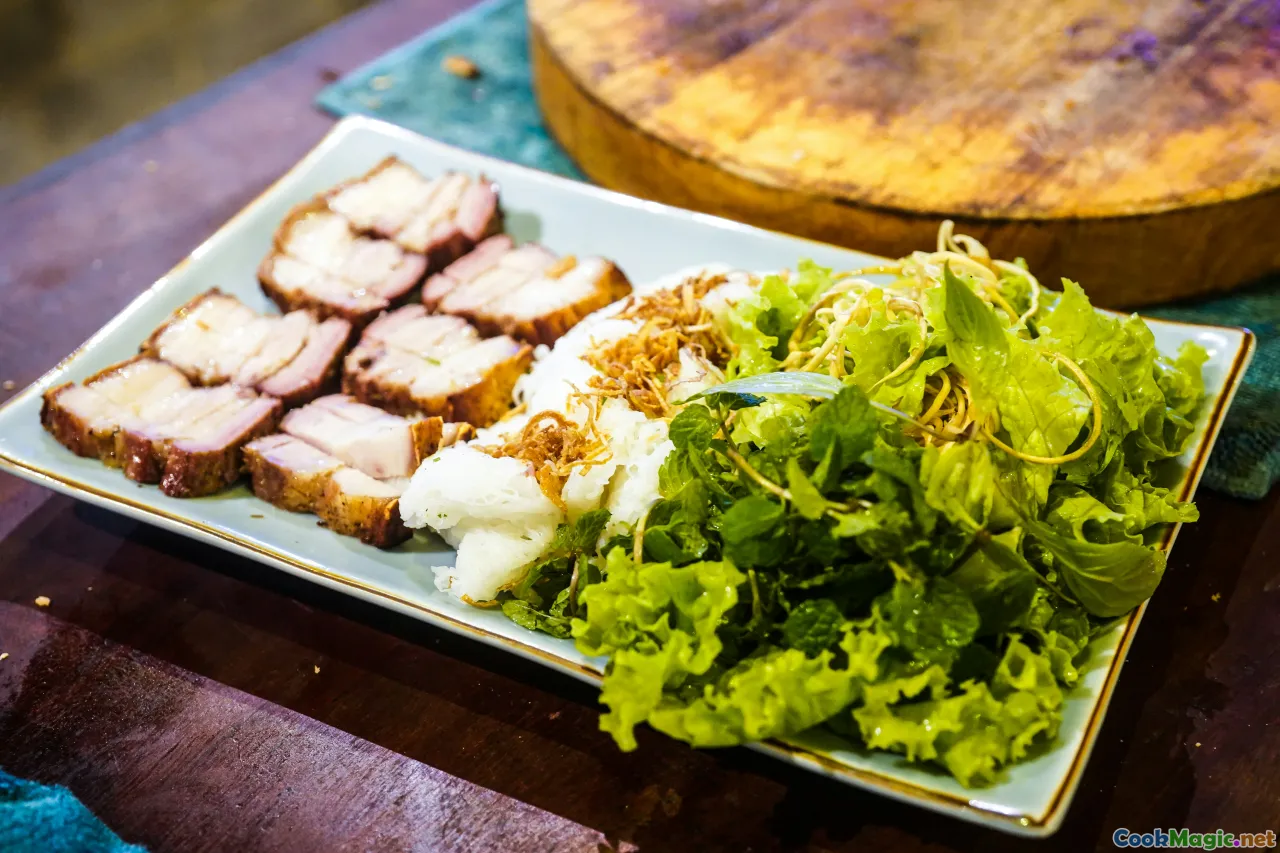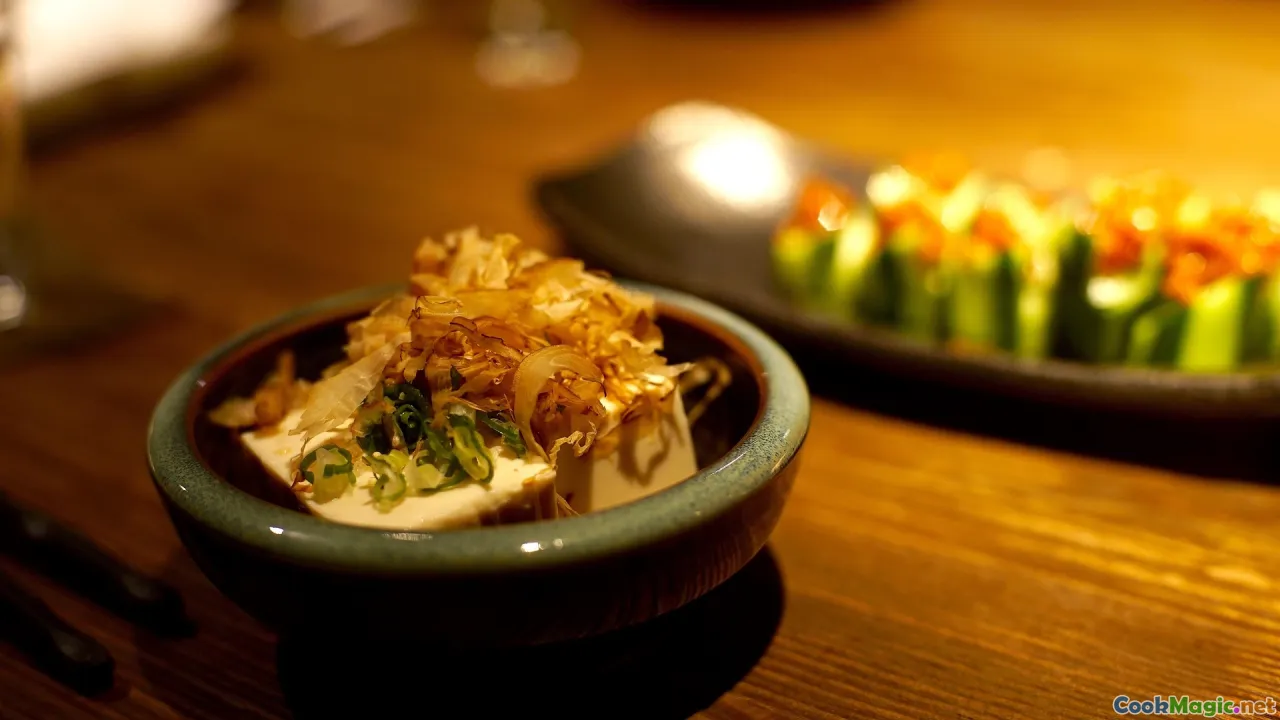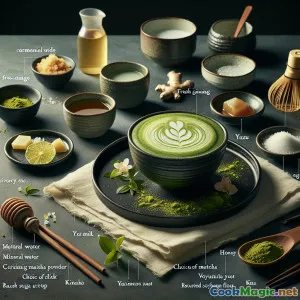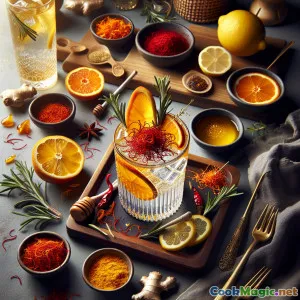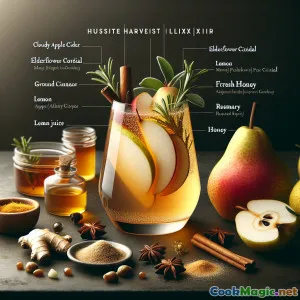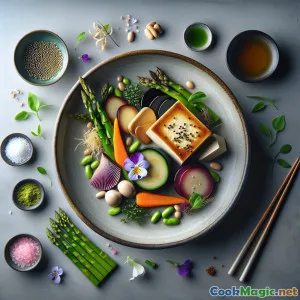
कैसेकी गार्डन हार्मनी: गार्डन कैसेकी व्यंजन
(Kaiseki Garden Harmony: Garden Kaiseki Delicacies)
(0 समीक्षाएँ)सामग्री
-
200 grams रेशमी टोफू
(फर्म टोफू भी काम करता है; सर्वोत्तम परिणामों के लिए स्थानीय कारीगर टोफू का प्रयोग करें.)
-
2 tablespoons मيسो पेस्ट
(नाज़ुक स्वाद के लिए सफेद या पीला.)
-
1 small बैंगन (Eggplant)
(जैविक प्राथमिकता)
-
4 whole बेबी गाजर
(विविध रंग प्लेट की कला को निखारते हैं)
-
4 spears ताजा शतावरी
(कटा हुआ)
-
30 grams एडामामे बीन्स
(छिले हुए)
-
200 ml सब्जी का स्टॉक
(अगर संभव हो तो घर का बना)
-
1 tablespoon चावल का सिरका
(टोफू में चमक जोड़ता है)
-
1 teaspoon तिल का तेल
(शुद्ध, भुना हुआ)
-
0.5 teaspoon समुद्री नमक
(सबसे बेहतर परतदार बनावट | स्वादानुसार)
-
10 grams माइक्रोग्रिन्स
(अरुगुला, मटर के अंकुर, या मूली के अंकुर)
-
8 pieces खाने योग्य फूल
(रंग के लिए पैंसी या नेस्टरटियम)
(फर्म टोफू भी काम करता है; सर्वोत्तम परिणामों के लिए स्थानीय कारीगर टोफू का प्रयोग करें.)
(नाज़ुक स्वाद के लिए सफेद या पीला.)
(जैविक प्राथमिकता)
(विविध रंग प्लेट की कला को निखारते हैं)
(कटा हुआ)
(छिले हुए)
(अगर संभव हो तो घर का बना)
(टोफू में चमक जोड़ता है)
(शुद्ध, भुना हुआ)
(सबसे बेहतर परतदार बनावट | स्वादानुसार)
(अरुगुला, मटर के अंकुर, या मूली के अंकुर)
(रंग के लिए पैंसी या नेस्टरटियम)
पोषण
- परोसने की संख्या: 2
- सेवा आकार: 1 सजाई गई थाली (220 g)
- Calories: 315 kcal
- Carbohydrates: 32 g
- Protein: 19 g
- Fat: 13 g
- Fiber: 9 g
- Sugar: 7 g
- Sodium: 720 mg
- Cholesterol: 0 mg
- Calcium: 210 mg
- Iron: 4.2 mg
निर्देश
-
1 - सब्ज़ियाँ पतली स्लाइस में काटें:
बैंगन को सावधानी से पतली गोल स्लाइस में काटें, गाजर और शतावरी तैयार करें.
-
2 - भाप में पका हुआ टोफू:
टोफू के ब्लॉक को आधे में काट दें। 10 मिनट तक भाप दें, जब तक वह गर्म हो जाए।
-
3 - सीज़न किया हुआ मिसो सॉस तैयार करें:
एक छोटे कटोरे में मिसो पेस्ट, गरम सब्ज़ी स्टॉक, चावल का सिरका और तिल के तेल मिलाएं। चिकना होने तक हिलाते रहें।
-
4 - ग्रिल की हुई सब्ज़ियाँ:
बैंगन, गाजर और शतावरी को हल्के से तिल के तेल से कोट करें। हर तरफ से ग्रिल करें जब तक वे नरम और कैरामेलाइज़ हो जाएँ।
-
5 - Edamame को हल्का उबालना:
एडामामे को उबलते नमकीन पानी में 2 मिनट ब्लांच करें. छलनी से निथारकर सुखा दें.
-
6 - प्लेट को सुंदर ढंग से सजाएं.:
केंद्र में स्टीम किया हुआ टोफू रखें। ग्रिल की हुई सब्ज़ियाँ और एडामामी को कलात्मक ढंग से व्यवस्थित करें। टोफू के ऊपर मिसो सॉस डालें, प्लेट पर माइक्रोग्रीन्स और खाने योग्य फूल बिखेर दें।
बैंगन को सावधानी से पतली गोल स्लाइस में काटें, गाजर और शतावरी तैयार करें.
टोफू के ब्लॉक को आधे में काट दें। 10 मिनट तक भाप दें, जब तक वह गर्म हो जाए।
एक छोटे कटोरे में मिसो पेस्ट, गरम सब्ज़ी स्टॉक, चावल का सिरका और तिल के तेल मिलाएं। चिकना होने तक हिलाते रहें।
बैंगन, गाजर और शतावरी को हल्के से तिल के तेल से कोट करें। हर तरफ से ग्रिल करें जब तक वे नरम और कैरामेलाइज़ हो जाएँ।
एडामामे को उबलते नमकीन पानी में 2 मिनट ब्लांच करें. छलनी से निथारकर सुखा दें.
केंद्र में स्टीम किया हुआ टोफू रखें। ग्रिल की हुई सब्ज़ियाँ और एडामामी को कलात्मक ढंग से व्यवस्थित करें। टोफू के ऊपर मिसो सॉस डालें, प्लेट पर माइक्रोग्रीन्स और खाने योग्य फूल बिखेर दें।
कैसेकी गार्डन हार्मनी: गार्डन कैसेकी व्यंजन :के बारे में ज़्यादा जानकारी
Kaiseki Garden Harmony: A Celebration of Japanese Culinary Elegance
Kaiseki Garden Harmony is my tribute to the ancient Japanese kaiseki tradition, artfully expressed through a vibrant medley of tofu, seasonal vegetables, tangy miso, and nature’s palate of edible flowers. This recipe marries the grace of Japanese haute cuisine with an accessible, plant-based ethos, making it not only deeply satisfying to eat but a joy to prepare and present.
🪴 The Inspiration and Philosophy
Kaiseki dining is as much culinary performance as it is gastronomy—prizing harmony, balance, and a sense for the fleeting beauty of the changing seasons. Classically, a kaiseki meal comprises a series of small, exquisitely-plated dishes that each showcase an ingredient’s essence. The hallmark is respect for the natural beauty and flavor of premium, local, seasonal fare. In this dish, humble tofu is elevated by luxurious miso and accompanied by bursts of color and flavor from market-fresh vegetables. Each element is treated so as to bring forth both contrast (roasted smokiness and fresh herbal notes) and consonance (velvety, pearlescent tofu offset by bright, lively microgreens).
🌷 Unique Aspects & Elegant Plating
What sets Kaiseki Garden Harmony apart is the intentionality in every bite. It’s not simply a plant-based platter; its logic is grounded in centuries-old Japanese customs—never overshadowing the core flavors, yet transforming them through gentle technique. The recipe harnesses gastronomic contrasts—warm versus cool, soft versus firm, umami base versus tangy top notes—not just to please the tongue, but to delight the eye with every plate.
Plating is an act of creation here. Like gardeners, chefs become arrangers—a few soft clusters of microgreens evoke a forest glade, while edible blossoms hint at the riotous beauty of spring. Let the arrangement reflect your mood and the seasons. When possible, seek out multi-colored baby carrots or purple asparagus tips for a riot of jewel tones. The inclusion of flowers, though optional, connects dinner to nature’s festive moments.
🍶 Tips & Tricks for Refinement
- Homemade Tofu Spoils You: Using fresh, artisanal tofu elevates the flavor far above supermarket blocks. Try sourcing locally made tofu if available;
- Test Your Grill: Charring vegetables gently intensifies flavor. Use a hot griddle pan to form attractive grill marks and caramelize sugars without burning;
- Don’t Overdo Miso: White or yellow miso’s graceful delicacy keeps the sauce from overpowering tofu’s clean taste;
- Edamame Pop: Add a sprinkle of good sea salt just before plating for bright, fresh taste—the salt lifts everything subtly.
🌸 Cultural Significance
Eating in the kaiseki style is considered a slow, meditative act in Japan. Diners are encouraged to contemplate not only flavor but artistry, transience (the fleetingness of perfectly fresh peas, the blossom in momentary full bloom), and connection to the land. It is fundamentally about deepening your appreciation for impermanence and beauty in the everyday.
By making Kaiseki Garden Harmony, you weave yourself a ‘miniature festival.’ Even for a quiet lunch at home, this meal can make you feel present and renewed—just as much a celebration of self-care as of formal dining.
📝 Additional Personal Notes
As a chef, I take special joy in recipes like this, where artistry and nourishment become one. Be unafraid to let the seasons guide small changes—swap squash for aubergine in autumn, use fresh snow peas or wild garlic in the spring. Gateways such as this delicious vegan-friendly kaiseki tasting platter encourage us to bring both earth and artistry to our tables, no matter where in the world we find ourselves.
In Summary: Kaiseki Garden Harmony offers an elevated, thoughtful meal experience with deep cultural roots. Precision in preparation, reverence in plating, and an eye for nature’s beauty—not to mention excellent nutrition—combine to create something truly special.


